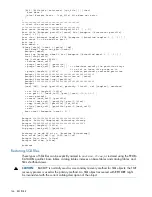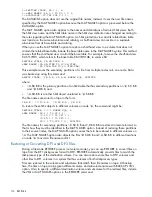
1> RESTORE $TAPE, $A.*.*, &
1> &MAP NAMES ($A.*.* TO $C.*.*) &
1> &CATALOGS ($C.CAT FOR C.*.*)
The CATALOGS option does not use the original file names; instead, it uses the new file names
specified by the MAP NAMES option because the MAP NAMES option is processed before the
CATALOGS option.
The MAP NAMES option also applies to the names and definitions of restored SQL views. Both
the SQL view name and the SQL table name in the SQL view definition are changed according to
the rules regarding the MAP NAMES option. An SQL protection view and its related base table
must reside on the same subvolume and catalog; a shorthand view can reside in a separate
subvolume from its base table and catalog.
When you use the MAP NAMES option to restore a shorthand view to a volume that does not
contain the related base table, include the base table name in the MAP NAMES syntax. This method
ensures that the shorthand view can find the base table. For example, to move the shorthand view
$A.SH.VIEW, which refers to the base table $B.VIEW.TAB, to volume $C:
RESTORE $TAPE, $A.SH.VIEW, &
&MAP NAMES ($A.SH.VIEW TO $C.SH.VIEW,
($B.VIEW.TAB TO $C.VIEW.TAB)
This example moves the secondary partitions of a file from multiple nodes onto one node. Data
was backed up using this command:
BACKUP $TAPE, ($B.B.B, $D.B.B) WHERE SQL, AUDITED
where:
•
\A.$B.B.B is the primary partition of an SQL table that has secondary partitions on \C.$C.B.B
and \D.$D.B.B, and...
•
\A.$D.B.B is another SQL object unrelated to \A.$B.B.B
The file names are stored on tape in the form:
$B.B.B , \C.$C.B.B , \D.$D B.B , $D.B.B
To restore these SQL objects to different volumes on node \A, the command might be:
RESTORE $TAPE, *.*.* WHERE SQL, &
&MAP NAMES ($B.*.* TO $F.*.*,
\C.$C.*.* TO $F1.*.*,
\D.$D.*.* TO $F2.*.*,
$D.*.* TO $F3.*.*), AUDITED
The file names for secondary partitions \C.$C.B.B and \D.$D.B.B are stored in remote format, so
that is how they must be identified in the MAP NAMES option. Instead of restoring these partitions
to their source nodes, the MAP NAMES option causes them to be restored to different volumes on
\A. The MAP NAMES option also directs the files \D.$D.B.B and \A.$D.B.B to different locations
on node \A to avoid a file-name conflict.
Restoring or Converting DP1 and DP2 Files
During a file-mode RESTORE process (not volume mode), you can use RESTORE to convert files on
tape from the DP1 disk-process format to DP2. RESTORE automatically converts files to match the
disk-process type of the destination volume. You can also restore some files to DP2 volumes and
other files to DP1 volumes in a system that has volumes of both disk-process types.
Files are restored to the volume and subvolume that match their file names on tape. At backup
time, the files on tape can be given different volume and subvolume names with BACKUP's VOL
option. Also, to specify a different destination volume and subvolume for the restored files, include
the VOL or MAP NAMES options in the RESTORE command.
174
RESTORE
















































